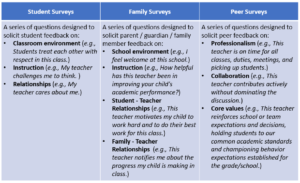Posts Tagged ‘Teacher Evaluation’
Put Excellence at the Heart of Performance Management
Performance management, at its core, sets expectations. It puts a stake in the ground for what “good” looks and sounds like in the classroom and serves as the baseline of teacher observation rubrics. Effective performance management is more than diagnosing current performance; it supports teachers to articulate an actionable, clear trajectory toward excellence. Ultimately, a vision of good teaching and learning must be at the heart of any performance management system.
Common Pitfall: Framework Without Vision
Too often schools and districts launch a performance management system by creating or selecting a rubric without consideration of core instructional priorities. Enthusiasm and urgency, while helpful, can lead to less than ideal system design.
For example, simply adopting an existing framework because it is “proven” or “research-based” might not actually lead schools and teachers to excellence: what might be excellent teaching in one context might not be true in another setting. Creating a framework from scratch in a vacuum, separate from instructional priorities, isn’t likely to lead teachers to excellence either.
This doesn’t mean that adopting an existing framework is the wrong strategy, or that creating something new won’t get leaders and teachers where they need to be. It does mean, though, that this work must be grounded in the core realities of instruction necessary to move kids.
Ground Performance Management in a Vision for Excellent Instruction
Co-design and co-own by instructional leaders. Defining excellence for as complex a role as teaching requires a team of individuals, with different areas of expertise and focus. While very often, the development of teacher evaluation systems lives within talent/human resources, great systems strategically draw in additional stakeholders. For quality operations, a talent leader should drive and own the design and implementation of a performance management framework. At the same time, this work should be a shared priority between leaders of talent, academics and school management functions in a network or district. Instructional leaders working in schools daily must be the core authors and implementers of expectations for teachers.
Measure what matters. If teachers are held to expectations through a framework that aligns with core instructional priorities, schools are more likely to see improvement in the areas that matter most for students. If a solid instructional vision grounds all decision making, then curricular resources, training, and other supports will naturally stem from that vision. As teachers are supported to meet expectations via appropriate the resources, materials, and training, student learning will flourish.
Lead from your vision. Consider the following questions, and strategically engage others to ensure answers reflect the perspectives of a broad range of stakeholders:
- What are our prevailing beliefs within our system about students, and the role teachers play in their success?
- What do the instructional standards require from our students? And then, by extension, from our teachers?
- In classrooms where good teaching and learning is happening, what are teachers doing? What are students doing?
- How does this differ for different students? Different contexts?
- How do we ensure that the performance management system we design reflects our vision of excellent teaching?
- Who will own this work? How will we ensure that leaders from talent and instruction both continue to be involved?
Let us know what you think in the comments below!
-Jessica
Designing Evaluation Frameworks with Development at the Core – Part III: Amplifying Stakeholder Voice with Surveys
This post is the third in a series on how innovators are reimagining the design and implementation of evaluation and development frameworks. Read our earlier posts on observation frequency and raising rubric rigor.
When you think of a teacher, where are they? What are they doing? If you envisioned someone standing in front of a blackboard, lecturing a group of students, you’re likely not alone. In reality however, teachers spend their days in a multitude of ways: working individually with students, collaborating with peers, planning independently, connecting with parents and family members.
Definitions of excellent teaching therefore must go beyond classroom observations and measures of student outcomes (both of which are important!), to gather a broader view of a teacher’s impact.
Surveys are a simple, yet powerful tool that can amplify the voices of stakeholders from across a school community to help educators develop a comprehensive view of excellence.
The Benefits of Administering Surveys
- Surveys, coupled with other measures like classroom observations, provide rich information to help teachers improve their practice. Teaching is a complex job that depends on strong relationships. While districts and schools have made progress in collecting data and providing feedback on certain aspects of the profession (e.g., content knowledge, teaching strategies, assessment data), our field often misses the opportunity to coach teachers on their relationship building with students, families and peers.
- Research says that students are reliable evaluators of a teacher’s impact. Analysis by the Measures of Effective Teaching (MET) project finds that teachers’ student survey results are predictive of student achievement gains. In other words, students know an effective classroom when they experience one.
- Surveys provide the opportunity to put values into practice. Value statements like “we are a team and family” or “parents are partners” are powerful; however, these beliefs are only as true as the actions taken to build an authentic community. Administering surveys of key stakeholders sends a strong message that the voices of community members are valued, respected and heard.
- Surveys provide clear and transparent expectations to teachers. When questions are shared with teachers in advance, the survey content provides clear definitions for expected behaviors in teacher-to-teacher, teacher-to-student, and teacher-to-family relationships. For example, if a survey asks families if they receive one or more positive phone calls a month from their child’s teacher, that sets a very clear expectations for the teacher-family relationship.
Survey Types
Educators have available a number of survey types, structures, question formats and administration platforms.The table below highlights three common survey types.
Surveys should be designed thoughtfully, taking into consideration the purpose, audience, and respondents.
- Purpose – Why are you administering the survey? What do you hope to learn? How will results be utilized?
- Audience – Who will analyze and interpret the survey results? When and how will they reflect on and plan from the results? How will the results be debriefed with teachers to improve practice?
- Respondents – Who will complete the survey? When and how will they complete the survey? What directions, supports and technology will be necessary for administration?

To learn more, including a list of sample survey questions, visit the resources page of our website.
Designing Evaluation Frameworks with Development at the Core – Part II: Raising Rubric Rigor
This post is the second in a series on how innovators are reimagining the design and implementation of evaluation and development frameworks. To read our first post in the series, on the impact of frequent observations, click here.

Most teacher evaluation systems today include direct observations of teacher practice by an administrator, in which the administrator determines ratings by assessing what they observed against a common performance rubric. It is challenging to capture the complexity of teaching in a single document, however strong rubrics have the capacity to set clear expectations, establish a common language, and chart a course for development over time.
During our work with school systems across the country, we have seen a few common challenges with widely-used rubrics:
1. Structure: Rubrics can be too long, wordy, and easy to master.
When rubrics are too lengthy, they can be overwhelming or intimidating to educators, fail to prioritize high-leverage teacher actions over lower-impact strategies, take too long for observers to complete and are challenging to norm across multiple raters. Additionally, when rubrics are too “easy”–that is when basic instruction with minimal impact on student learning aligns to language at the highest levels–we rob educators of a true pathway for growth in their careers and limit their potential for excellence.
2. Framing: Rubrics generally focus only on teachers.
When rubrics describe only what teachers are doing and saying they fail to take into account what matters most: the impact of instruction on students. This can limit the value of observation feedback and lead to misalignment between observation ratings and other components of an evaluation framework.
3. Content: Rubrics are often not aligned to today’s raised academic expectations.
When rubrics do not call for rigorous instruction aligned to core content standards (Common Core, Next Generation Science, etc.) they miss the opportunity to set expectations for learning at the appropriate bar. Similarly, as our knowledge of social-emotional learning, cultural competency, and technology expand, many rubrics have yet to adapt and account for new knowledge and skills.
In the face of these challenges, innovators are creating a new normal for observation rubrics. Through our partnership with school systems across the country, we have seen that there is no one right way or perfect rubric. Rather, systems need to consider their unique culture, expectations, observer skill level and existing structures to find or develop a rubric that will work best for them.
DREAM Charter School: DREAM prioritized finding a streamlined observation rubric that would be appropriately rigorous as teacher advances along their career while less cumbersome than the tool they had previously been using. Following research into available tools and piloting of a select few, DREAM identified the TNTP Core Teaching Rubric as the right resource: it was aligned to academic content standards, written in the form of student outcomes, and best of all, was only four pages long! DREAM revised some language to incorporate school-specific competencies that drive their unique student and adult culture. Following the first year of implementation, nearly 80% of teachers said the rubric defines excellent instruction well.
KIPP Houston Public Schools: The original and largest KIPP region is currently piloting the Reach to Rigor rubric, a new tool created in-house that defines academic and cultural expectations for teachers and students. The rubric is broken down into four parts with only the most critical components of great instruction included. The rubric language also includes both teacher and student actions, to ensure that instructional moves by the teacher are only deemed high-quality if they have the desired effect on student thinking and behavior.
Achievement First: One of the first movers in formalizing a career pathway for teachers, Achievement First has refined their approach to observation and feedback over time. The network developed and launched an updated AF Essentials Rubric that was intentionally designed to be concise, clear, focused on student actions. The rubric is aligned to the Common Core and expectations of Advanced Placement courses, shifting more emphasis to intellectual rigor and deep student thinking. The rubric includes both “foundational” (e.g., tight classroom or kids on task) and excellence (e.g., investment and deep student thinking) criteria.
What are other innovations in observation rubrics? Add your ideas and/or experiences in the comments section below.
5 Strategies for Scaling Effective Coaching
Our team spends a lot of time thinking about how to develop teachers. We believe that investing in the professional growth of teachers has the potential to dramatically change the landscape of education in our country and the lives of millions of children. While school systems across the U.S. spend billions of dollars annually on teacher professional learning and development we have little proof of their efficacy (The Mirage, TNTP 2015).
Given this context, we were thrilled to read a new study, The Effect of Teacher Coaching on Instruction and Achievement by Matthew Kraft and Dylan Hogan of Brown University and David Blazar from Harvard University. Kraft and his team conducted a meta-analysis of 37 studies and found coaching programs to positively impact instruction (.57 standard deviations) and student achievement (.11 standard deviations). The authors offer the following summary:
The results of our meta-analysis suggest that teacher coaching programs hold real promise for improving teachers’ instructional practice and, in turn, students’ academic achievement. These findings provide strong motivation to invest in efforts to scale up teacher coaching models, and to expand and improve upon the existing research base.
Effective Coaching
The authors characterize the coaching process as one where instructional experts work with teachers to discuss classroom practice in a way that is:
- Individualized: one-on-one sessions
- Intensive: frequent interaction between teachers and coaches (e.g., at least every couple of weeks)
- Sustained: coaching support over an extended period of time
- Context-specific: coaching on their practices within the context of a teacher’s classroom
- Focused: teachers and coaches engage in deliberate practice of specific skills
These findings support much of the work we have done with school systems including KIPP Austin Public Schools, DREAM Charter School and the Cleveland Metropolitan School District to grow talent through multiple-measure evaluation and development frameworks. Each of these organizations have employed innovations specific to their unique contexts, however common across all approaches is a theory of change that recognizes the critical role coaches play in moving teacher practice and ultimately student outcomes.
Scaling Systems of Effective Coaching
One of the most important insights in the analysis is data suggesting “that coaching can have an impact at scale” but that scaling-up programs (to more than 100 teachers) is challenging, particularly in building a cohort of capable coaches and in establishing strong teacher buy-in.
From our experience, these two factors matter mightily. There are certainly pockets of excellent coaching in every school system, but the real challenge of scale is consistency of implementation. Here are five strategies for solving the scale-up challenges described by Kraft, Blazar and Hogan:
1. Establish a common definition of excellence: Coaching is incredibly hard work as it requires deep content knowledge, pedagogical expertise, emotional intelligence and strong interpersonal communication skills. One the best steps we can take to set coaches up for success is adoption of a clear definition of excellent teaching (e.g., a robust rubric or vision of excellence document). In establishing a common bar of quality of important instructional practices and a common language, coaches and teachers have a clear development road-map to work along. You can read more about strong observation rubrics in this March 2017 post.
2. Make Tools Available: Great coaches need tools to guide their learning and development. School systems should develop and train leaders on a common observation debrief protocol or conversation guide such as Paul Bambrick’s 6-Steps to Effective Feedback or the TEF Debrief Planning Guide to structure coaching conversations. Systems for capturing, analyzing and sharing observation data including observation ratings and feedback are also vital for supporting coaching efforts.
3. Invest in ongoing leader development: Often lost in conversations around teacher professional development is the importance of ensuring professional learning for those responsible for coaching teachers. These professionals warrant the same level of thoughtful support. Summer is a great time to bring coaches together for intensive training but without ongoing follow-up, development can be lost or minimized. Managers of coaches should have talent development within their core responsibilities including time for managers to observe and support school leaders/coaches working with their teachers.
4. Build a Culture of Transparency and Continuous Improvement: Ultimately the work leaders do coaching teachers is only as impactful as the level of trust and partnership teachers feel in the relationship. Transparent communication of the “why” and “how” of key policies along with timelines, goals, and progress to-date is essential for successful long-term investment. Gathering frequent feedback with public recognition of the findings and appropriate next steps will build a culture of continuous improvement.
5. Phase-in implementation: As noted in the study, working one-on-one with any person over a sustained period requires an investment of time and money. Certainly shifting funds from less effective professional development activities toward coaching is a strong first step. Another strategy is to phase-in implementation of a coaching program to build capacity, gain early wins, expand the coalition of supporters, and prove the value of the financial investment. We suggest system leaders identify the core problem they are hoping to solve, then target the first phase of implementation toward that issue. For example, if a system seeks to solve the challenges that arise from new teachers lacking foundational classroom management skills they can launch a coaching program focusing on that subset of teachers. Over time, coaches could roll-off and target other groups of teachers for support or the program could expand with the hiring of additional coaches.
What approaches to coaching teachers have you seen work well? How have you built a cohort of strong coaches and/or invested teachers? Let us know in the comments below!
Great Leaders, Great Teachers: How Cleveland Metro is Investing in Leaders
In response to Race to the Top, many states, including Ohio, revised state statutes requiring school districts to develop new evaluation models. In a collaborative effort, the Cleveland Metropolitan School District and the Cleveland Teachers’ Union developed the Teacher Development and Evaluation System (TDES).
We partnered with the talent team at CMSD to develop tools and trainings designed to enhance administrators’ ability to successfully evaluate and develop their teachers. We began the engagement with a robust review of existing research and best practices in order to establish a clear description of the knowledge and skills necessary for leading effective observation and feedback.
Following stakeholder review and investment in the new district-wide expectations, we established a theory of action for building administrator capacity across the district, developing an aligned scope and sequence of training modules aimed at achieving CMSD’s goals. Each training module focuses on both observer calibration and quality feedback for improvement, sharing tools and protocols aimed at bridging the learning into the daily practice of administrators.
Taken together, these training modules provided administrators regular opportunities to reflect on and hone their practice as instructional leaders, improving teacher quality and ultimately, the achievement of students across the district.
Designing Evaluation Frameworks with Development at the Core – Part I
Encouraged by Race to the Top and the Department of Education’s ESEA waivers, teacher evaluations moved into the education policy limelight during the last decade. Dozens of states updated antiquated systems–usually nothing more than a checklist of low-impact items–into multiple measure approaches with student achievement a preponderant component.
While this was a critical first step, too many frameworks failed to prioritize teacher development, becoming compliance exercises for school leaders. Fortunately, innovators across the country are re-imagining the design and implementation of evaluation frameworks into evaluation and development frameworks.
Over the next few months, we will share examples of these innovations from various partners and leaders in the field. In our first post on the topic, we share how two school systems are using frequent, unannounced observations to drive teacher development.
The Power of Frequent Observations
Observations have historically been rather formal exercises, often with scheduled pre- and post-conferences designed to provide teachers and administrators with dedicated time to plan for and then reflect upon a lesson. While there is immense value in these face-to-face interactions, they come with limitations. The heavy time burden for scheduling and completing these meetings limits the frequency in which they can occur. Often, administrators will only be able to visit one to three times in year, reducing the impact of their feedback and diminishing their ability to provide meaningful follow-up support. Announced observations also increase the opportunity for a lesson to be less reflective of a teacher’s true daily practice.
Many school systems across the country are taking a different approach to observations:
The Teaching Excellence Framework is used by more than a half-dozen independent charter schools in Delaware as part of the state’s educator evaluation regulation (Chapter 12, subchapter VII, Section 1270(f)) that allows LEAs to apply to implement an alternative teacher evaluation system. The framework was designed with frequent lesson observations at the heart of the overall plan for teacher development. Observations are 15-20 minutes in length and occur at least 8 times throughout the year. Following each observation, the observer utilizes the Teaching Excellence Rubric to assess the evidence in the lesson. A face-to-face debrief conversation occurs within one week in which the teacher and school leader determine concrete, actionable next steps. As a result, 95% of teachers surveys reporting feeling ‘positive’ to ‘very positive’ about the shift to the Teaching Excellence Framework. You can learn more about the Teaching Excellence Framework here.
Understanding the importance of excellent teachers, in 2014 the DREAM Charter School in New York City set out to revamp their system for teacher evaluation and recognition. Recognizing their teachers wanted more frequent feedback, the design committee at DREAM developed a system that would include:
- Five unannounced observations throughout the year in which a teacher’s manager or a secondary observer determine ratings on the DREAM Observation Rubric
- Bi-weekly unannounced observations in which a teacher’s manager provides feedback and direct support, including real-time coaching (no ratings)
All observations are followed by coaching conversations focusing on strengths and growth areas of the teacher’s practice as well as instructional next steps. Following the first year of implementation, one teacher praised the approach noting “it gives teachers clear take aways and next steps” while another said “it is streamlined [and] it pushes for development.” To learn more about DREAM Charter School, you can visit their website here.
What are other innovations around observation frequency? Add your ideas and/or experiences in the comments section below.
Welcome to the Hendy Avenue Blog
Welcome to Hendy Avenue Consulting’s new blog!
Over the past four years, we have have been fortunate to partner with wonderful school systems across the country to help them grow and retain talent. And we’ve learned a lot! We are excited to launch this site as an opportunity to share what we’re learning, disseminate research, highlight best practices, present case studies of promising practices and post interviews with leaders in the field.
In the coming weeks, we will publish posts on how school systems can put teacher development at the core of evaluations, a case study of how KIPP Austin is investing in teachers, and a run-down of some of the recent research we have been reading.
We hope you enjoy each post, leave comments, and share with those in your network.
At Hendy Avenue Consulting, we believe that investing in talent has the potential to dramatically change the landscape of education in our country and the lives of millions of children. You can learn more about us and our work here.






